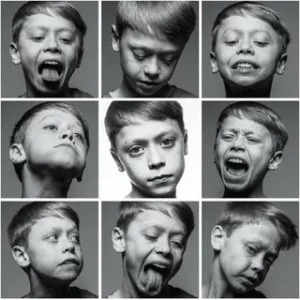- 8 February 2024
- 185
Tourette’s Deconstructed: Basic Principles Unraveled

Introduction
Tourette syndrome is a neurological disorder characterized by repetitive, involuntary movements and vocalizations known as tics. Despite being relatively well-known, Tourette’s can still be misunderstood or misrepresented. In this article, we’ll unravel the basic principles of Tourette’s syndrome, exploring its symptoms, causes, diagnosis, and management strategies.
Understanding Tourette Syndrome
Symptoms
Tourette’s syndrome manifests through a variety of motor and vocal tics, which can range from mild to severe:
- Motor Tics: Involuntary movements such as eye blinking, head jerking, shoulder shrugging, or facial grimacing.
- Vocal Tics: Uncontrollable sounds or words, including throat clearing, sniffing, grunting, or repetitive speech.
Onset and Presentation
Tourette’s typically emerges in childhood, with symptoms often appearing between the ages of 2 and 12. The severity and frequency of tics can fluctuate over time, with some individuals experiencing periods of remission or symptom improvement.

Unraveling the Causes
Genetic Factors
While the exact cause of Tourette’s syndrome remains unknown, genetic factors are believed to play a significant role:
- Family History: Tourette’s tends to run in families, suggesting a genetic predisposition to the disorder.
- Genetic Variants: Specific gene variants have been associated with an increased risk of developing Tourette’s, although the inheritance pattern is complex and multifactorial.
Neurological and Environmental Influences
In addition to genetic factors, various neurological and environmental factors may contribute to the development of Tourette’s syndrome:
- Brain Structure and Function: Differences in brain structure and neurotransmitter function, particularly involving dopamine and serotonin, may influence tic expression.
- Prenatal and Perinatal Factors: Exposure to certain prenatal or perinatal factors, such as maternal smoking, infections, or complications during childbirth, may increase the risk of Tourette’s.
Diagnosis and Evaluation
Clinical Assessment
Diagnosing Tourette’s syndrome involves a comprehensive clinical assessment, which may include:
- Medical History: Evaluating symptoms, onset, severity, and family history of tic disorders.
- Physical Examination: Assessing motor and vocal tics, as well as any associated behavioral or psychiatric symptoms.
- Diagnostic Criteria: Referring to established diagnostic criteria, such as those outlined in the Diagnostic and Statistical Manual of Mental Disorders (DSM-5).
Differential Diagnosis
Distinguishing Tourette’s syndrome from other neurological or psychiatric conditions is essential:
- Other Tic Disorders: Differentiating between Tourette’s and other tic disorders, such as persistent (chronic) motor or vocal tic disorder.
- Neurological Conditions: Ruling out underlying neurological conditions that may mimic or coexist with Tourette’s, such as epilepsy or movement disorders.
Management Strategies
Multidisciplinary Approach
Managing Tourette’s syndrome often requires a multidisciplinary approach involving various healthcare professionals:
- Medical Management: Prescribing medications to reduce the frequency and severity of tics, such as antipsychotics, alpha-2 adrenergic agonists, or dopamine blockers.
- Behavioral Therapy: Engaging in behavioral interventions, such as habit reversal therapy or exposure and response prevention, to help manage tics and associated symptoms.
- Supportive Care: Providing education, support, and resources for individuals and families affected by Tourette’s, including support groups and psychoeducation programs. Explore More About ( Leprocy in Florida)

Individualized Treatment Plans
Tailoring treatment plans to meet the unique needs and preferences of each individual is essential:
- Shared Decision-Making: Collaborating with patients and families to discuss treatment options, goals, and potential risks and benefits.
- Regular Monitoring: Monitoring tic severity, medication effectiveness, and any adverse effects to adjust treatment as needed over time.
- Holistic Approach: Considering the impact of Tourette’s on various aspects of daily life, including academic, social, and emotional functioning, when developing treatment plans.
Conclusion
Tourette’s syndrome is a complex neurological disorder characterized by involuntary motor and vocal tics. While there is still much to learn about its underlying causes and optimal management strategies, a multidisciplinary approach involving medical, behavioral, and supportive interventions can help individuals affected by Tourette’s lead fulfilling and productive lives.

